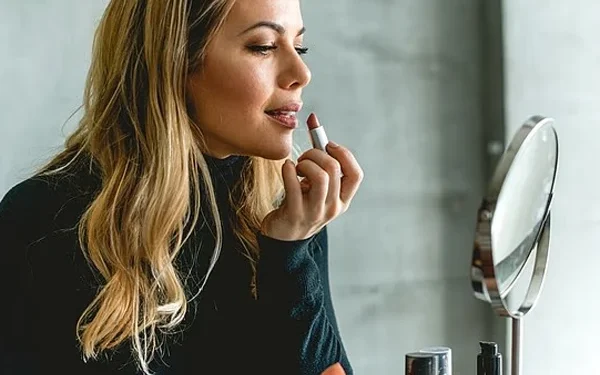Introduction: The Hidden Health Risks Behind Everyday Beauty Products
Makeup has long been a part of many women’s daily routines, enhancing appearance and boosting confidence. However, a recent scientific study has raised concerns about the potential health risks associated with frequent cosmetic use, particularly among women who wear makeup regularly. According to research conducted by the National Heart, Lung, and Blood Institute (NHLBI) in the United States, women who use cosmetics daily—such as lipstick, blush, mascara, and fake nails—may have a significantly higher risk of developing asthma later in life.
Published in the reputable journal Environment International, this comprehensive study analyzed data from nearly 40,000 individuals over a 12-year period, uncovering startling links between beauty products and respiratory health issues. While the findings do not definitively establish causation, they suggest that the chemical ingredients commonly found in makeup and cosmetic products could contribute to the onset of asthma and other chronic respiratory conditions.
The Study at a Glance: How Researchers Linked Makeup Use to Asthma
Study Overview
- Institution: National Heart, Lung, and Blood Institute (USA)
- Journal: Environment International
- Duration: 12 years
- Participants: Nearly 40,000 individuals
- Focus: Relationship between makeup/cosmetic product usage and asthma development
Researchers tracked participants’ use of 41 different cosmetic and personal care products, such as:
- Lipstick
- Eye shadow
- Mascara
- Blush
- Fake nails
- Cuticle cream
Women who used these products frequently—particularly blush and lipstick five or more times per week—showed a notable 18% increase in asthma risk, while those who used a combination of makeup items regularly were 47% more likely to develop asthma.
Asthma Explained: What You Need to Know About This Chronic Disease
What is Asthma?
Asthma is a chronic inflammatory disease of the airways that causes symptoms such as:
- Wheezing
- Shortness of breath
- Chest tightness
- Coughing, especially at night or early morning
The disease can vary in severity from mild to life-threatening. Triggers may include allergens, air pollution, respiratory infections, exercise, and increasingly—as this new study suggests—chemical exposure through personal care products.
Why Asthma in Adults Is a Growing Concern
While asthma is commonly diagnosed in childhood, adult-onset asthma is a growing public health concern. Women are particularly at risk due to hormonal fluctuations, workplace exposures, and, as emerging evidence shows, chronic exposure to environmental toxins, including those found in makeup and beauty products.
What Are the Harmful Chemicals in Makeup?
The cosmetics industry uses thousands of chemical ingredients, many of which are unregulated or minimally tested for long-term health effects. Several of these have been identified as potential endocrine disruptors or respiratory irritants.
Key Chemicals of Concern:
- Phthalates – Often used in nail polish, perfumes, and hairsprays. Known to disrupt hormones and have been linked to asthma.
- Parabens – Preservatives found in many creams and makeup products; associated with hormonal imbalance.
- Toluene – Common in nail products; known to affect respiratory function and irritate lungs.
- Formaldehyde and Formaldehyde-releasing agents – Found in nail hardeners and some mascaras; classified as carcinogenic and a respiratory hazard.
- Fragrance compounds – These are often proprietary blends of chemicals that can trigger allergic reactions or asthma.
The combination of these ingredients—used frequently and over long periods—raises concerns about their cumulative impact on health.
How Cosmetics May Affect Respiratory Health
The inhalation or absorption of cosmetic ingredients over time can lead to chronic inflammation in the lungs or increased sensitivity of the airways, both of which contribute to asthma. Here’s how:
Mechanisms of Impact:
- Inhalation of aerosols from sprays, powders, or perfumes can irritate the lungs directly.
- Skin absorption of harmful chemicals can enter the bloodstream and trigger systemic inflammation.
- Immune response alteration caused by endocrine disruptors can weaken the body’s ability to regulate inflammation in the lungs.
The Data: Breaking Down the Numbers
According to the study:
- Women who used multiple beauty products frequently had a 47% higher risk of developing asthma than those who used them rarely or not at all.
- Regular use of blush and lipstick five times or more per week alone increased asthma risk by 18%.
- These risks were found independent of other lifestyle factors, such as smoking or existing respiratory conditions, which adds weight to the association between chemical exposure through makeup and asthma risk.
Expert Opinions: What Health Professionals Are Saying
Dr. Jane Harris, Pulmonologist:
“This study raises a red flag about the cumulative effects of cosmetics on our respiratory health. While the findings are not yet conclusive, they suggest we should be cautious and informed about the ingredients in our everyday products.”
Dr. Laura Simmons, Environmental Health Researcher:
“We’ve known for a while that certain chemicals in consumer products can disrupt hormonal and immune systems. This study is a strong indication that these substances may also affect respiratory health, particularly in women.”
Implications for the Cosmetics Industry
The findings from this study are likely to increase consumer demand for transparency, as well as pressure on regulators to examine the long-term health implications of cosmetic ingredients more thoroughly.
Current Regulations and Gaps:
- In many countries, including the United States, cosmetic products are not required to undergo safety testing before reaching the market.
- Ingredients listed as “fragrance” can legally include hundreds of unlisted chemicals.
- The European Union has banned over 1,300 chemicals in cosmetics, while the U.S. has banned fewer than 50.
Tips for Safer Cosmetic Use
While this study doesn’t suggest women stop using makeup altogether, it encourages consumers to be more selective and better informed about what they’re applying to their skin.
How to Reduce Risk:
- Choose products labeled “fragrance-free” and “paraben-free.”
- Limit use of aerosol sprays and powder-based products.
- Opt for brands that use organic or plant-based ingredients.
- Check for certifications like EWG Verified, Leaping Bunny, or Made Safe.
- Read ingredient labels carefully—even on natural brands.
- Give your skin a break—go makeup-free on weekends or when working from home.
Conclusion: Awareness Is the First Step Toward Prevention
The results of this long-term study underscore a growing concern in the field of environmental and respiratory health: the potential danger of frequent exposure to toxic chemicals hidden in everyday beauty products. While further research is needed to establish causality, the association between frequent cosmetic use and increased asthma risk in women is strong enough to warrant caution.
For women who wear makeup regularly, the best approach is to stay informed, read labels, and minimize exposure to products with harmful ingredients. As the beauty industry evolves, consumers must push for safer, more transparent cosmetic formulations that do not compromise long-term health for short-term aesthetics.

























